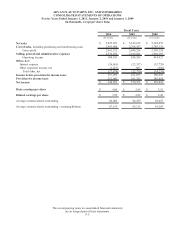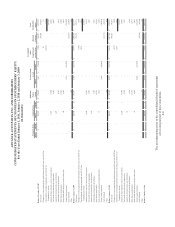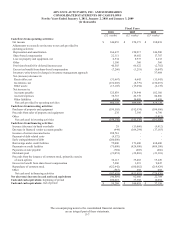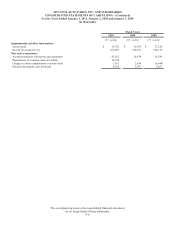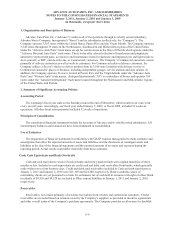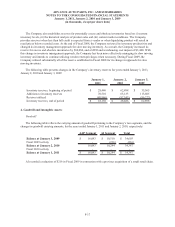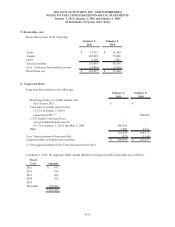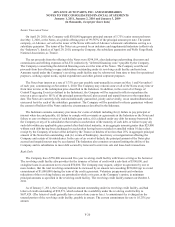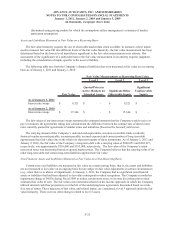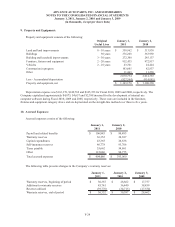Advance Auto Parts 2010 Annual Report Download - page 68
Download and view the complete annual report
Please find page 68 of the 2010 Advance Auto Parts annual report below. You can navigate through the pages in the report by either clicking on the pages listed below, or by using the keyword search tool below to find specific information within the annual report.ADVANCE AUTO PARTS, INC. AND SUBSIDIARIES
NOTES TO THE CONSOLIDATED FINANCIAL STATEMENTS
January 1, 2011, January 2, 2010 and January 3, 2009
(in thousands, except per share data)
.
F-14
shareholders by the weighted-average common shares outstanding during the period. The two-class method is an
earnings allocation formula that determines income per share for each class of common stock and participating
security according to dividends declared and participation rights in undistributed earnings. Diluted income per
common share reflects the more dilutive earnings per share amount calculated using the treasury stock method or the
two-class method.
Basic earnings per share of common stock has been computed based on the weighted-average number of
common shares outstanding during the period, which is reduced by stock held in treasury and shares of nonvested
restricted stock. Diluted earnings per share of common stock reflects the weighted-average number of shares of
common stock outstanding, outstanding deferred stock units and the impact of outstanding stock options, and stock
appreciation rights (collectively “share-based awards”). Share-based awards containing performance conditions are
included in the dilution impact as those conditions are met. Diluted earnings per share are calculated by including
the effect of dilutive securities.
Lease Accounting
The Company leases certain store locations, distribution centers, office space, equipment and vehicles. Initial
terms for facility leases are typically 10 to 15 years, with renewal options at five year intervals, and may include rent
escalation clauses. The total amount of the minimum rent is expensed on a straight-line basis over the initial term of
the lease unless external economic factors exist or become existent such that renewals are reasonably assured, in
which case the Company would include the renewal period in its amortization period. In those instances, the renewal
period would be included in the lease term for purposes of establishing an amortization period and determining if
such lease qualified as a capital or operating lease. In addition to minimum fixed rental payments, some leases
provide for contingent facility rentals. Contingent facility rentals are determined on the basis of a percentage of sales
in excess of stipulated minimums for certain store facilities as defined in the individual lease agreements. Most of
the leases provide that the Company pay taxes, maintenance, insurance and certain other expenses applicable to the
leased premises. Management expects that in the normal course of business leases that expire will be renewed or
replaced by other leases.
Property and Equipment
Property and equipment are stated at cost, less accumulated depreciation. Expenditures for maintenance and
repairs are charged directly to expense when incurred; major improvements are capitalized. When items are sold or
retired, the related cost and accumulated depreciation are removed from the account balances, with any gain or loss
reflected in the consolidated statements of operations.
Depreciation of land improvements, buildings, furniture, fixtures and equipment, and vehicles is provided over
the estimated useful lives, which range from 2 to 30 years, of the respective assets using the straight-line method.
Depreciation of building and leasehold improvements is provided over the shorter of the original useful lives of the
respective assets or the term of the lease using the straight-line method. The term of the lease is generally the initial
term of the lease unless external economic factors exist such that renewals are reasonably assured, in which case the
renewal period would be included in the lease term for purposes of establishing an amortization period.
Closed Store Liabilities
The Company continually reviews the operating performance of its existing store locations and closes or
relocates certain stores identified as underperforming or delivering strategically or financially unacceptable results.
Expenses pertaining to closed store exit activities are included in the Company’s closed store liabilities. Closed store
liabilities include the present value of the remaining lease obligations and management’s estimate of future costs of
insurance, property tax and common area maintenance expenses (reduced by the present value of estimated revenues
from subleases and lease buyouts) and new provisions are established by a charge to selling, general and
administrative expenses, or SG&A, in the accompanying consolidated statements of operations at the time the
facilities actually close.



